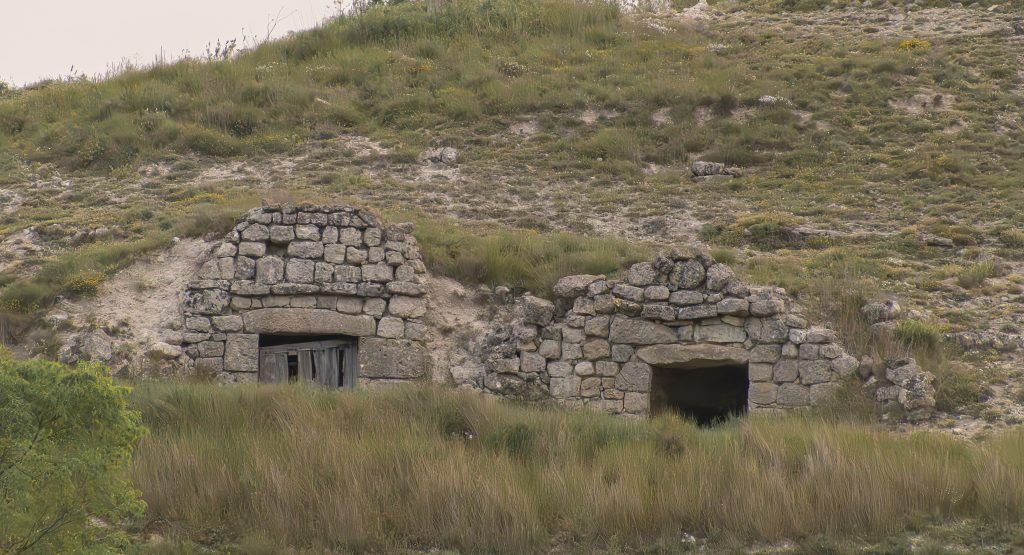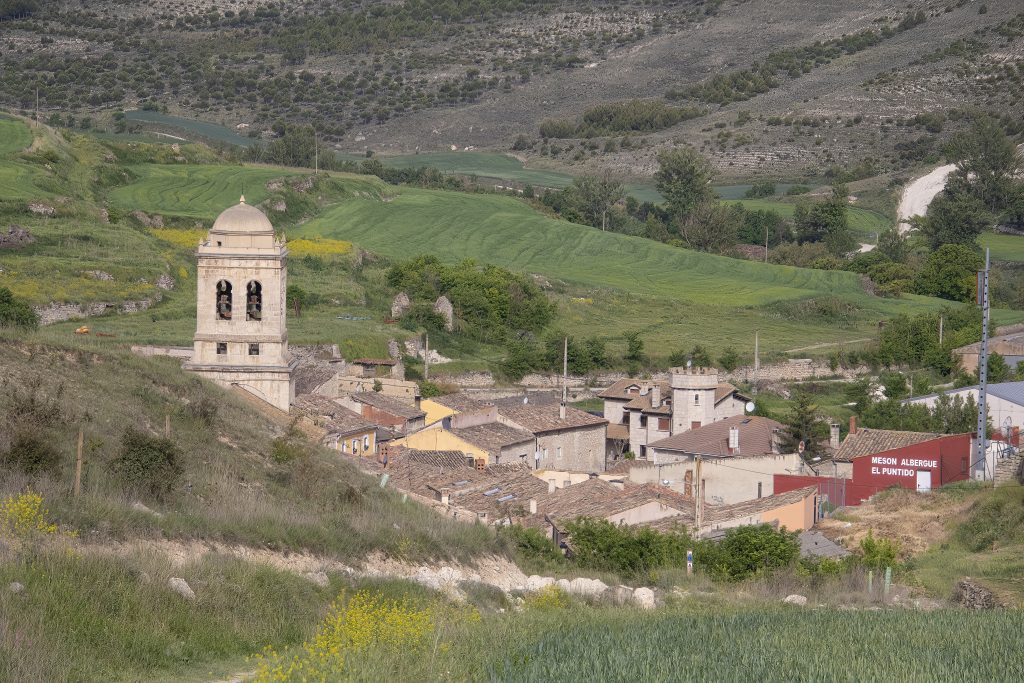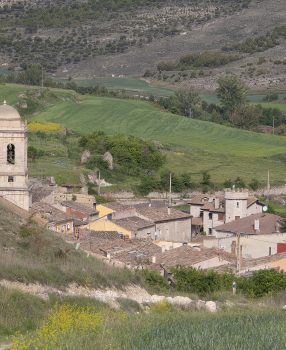With our sights set on Hontanas, we set off from Hornillos. The day was overcast but clear with no rain forecast. Not far from the town, Sharon’s shoelace came loose, and as she bent to re-tie it she felt a sharp pain from her hip flexor muscle — a continuing legacy of our ill-judged decision to walk the Valcarlos route on the second day of our Camino.

We walked to San Bol. It appeared as a small collection of buildings about 500m from the main track off to the left. As we were about 5km out of Hornillos it seemed a good place to stop for a break. It was not a hamlet, just a municipal donativo albergue — no food, just an available toilet — otherwise deserted.
We passed more Hobbit-like structures built into the rolling hillside — perhaps storm shelters or storage for tools or produce.

The windmills tower over the wheatfields choreographed to their own rotational rhythm.
Climbing a second mesa, or flat-topped hill we continued on for another few kilometres before the town of Hontanas came into view. It arrives at the last minute, as it rests in a hollow among the flat landscape.
At the entrance to Hontanas on the right is a small stone structure — a tiny hermitage dedicated to St Bridget of Sweden, situated in a little park not much bigger than a suburban backyard. Inside is a small bench and a statue of the saint. It’s a delightful space for some quiet contemplation. St Bridget is co-patron saint of Europe and the hermitage was established as a small meeting place for pilgrims. She made her own pilgrimage to Santiago in 1341 — it must have been quite a journey for a Swedish noblewoman.
So who is this courageous woman? — a Catholic mystic born into a wealthy family, some say she was Princess of Nericia. Born in 1303, she was married at 13 years of age — shocking today, but not so unusual in the 1300s when life expectancy was much shorter. She had eight children, including Catherine of Vadzstena who was to become Abbess of Vadzstena until her death in 1381, and she, too, was canonised as a saint in 1484.
Bridget had visions of Christ since she was seven years old and was known throughout her life for her charitable work. In her early 30s, she was summoned to be the principal lady-in-waiting to the new queen of Sweden Blanche of Namur. Then she undertook her pilgrimage to Santiago with her husband. Not long after they returned to Sweden in 1344, her husband died. Bridget entered holy orders, becoming a member of the Third Order of St Francis, and dedicating the rest of her life to caring for the poor and sick. This led her to establish her own religious community which became known as the Order of the Most Holy Saviour, or the Brigettines. This order was richly endowed by King Magnus IV of Sweden — it pays to have wealthy connections in high places…
Thirteen-Fifty was a Jubilee year, and despite bubonic plague ravaging Europe, she made a pilgrimage to Rome accompanied by her daughter Catherine, along with a party of priests and disciples. One of the aims of this pilgrimage was to gain authorisation from the Pope for the founding of her Order. The slight technical hitch was that this was during the time of the Avignon papacy, and, perhaps controversially, she agitated for many years for the return of the papal seat to Rome. Finally, in 1370, Pope Urban V made a shortlived attempt to return the papacy to Rome, during which he finally authorised the official founding of her Order. Tenacity pays off in the end!
The thing about saints is that regardless of who they were as individuals, the idea is that they become exemplars of an ideal form of humanity, that they remind us to be kinder to each other, and look out for each other on this grand journey we call life. In this sense, saints are like performers — a persona rather than the person behind the persona. Indeed her detractors, perhaps the Devil’s Advocate, have suggested she damaged King Magnus and Queen Blanche by accusing them of ‘erotic deviations, extravagance and murderous plots’, while others have suggested she used personally and politically motivated mud-slinging against people she didn’t like.
Martin Luther, initially attracted to her Revelations, later concluded that her visions were mere ravings. Regardless of the reality of the person, the value of sainthood, like the many legends on the Camino, rests with the ideal presented as persona and exemplar to which we might aspire in our lives. Saints are perhaps the evidence that we can all aspire to be better than we are at present. They embody and represent the ideal life in which we can identify the humanity in others, and ultimately this is what is important. After all, are we not capable of being both saints and sinners?
We talked of ‘thin’ places — said to be places where the divide between the natural and supernatural world is thin and easily crossed. I wonder if it relates to the ‘magic realism’ of Spanish literature like Cervantes or in art like Picasso or Dali?
There sometimes feels like a kind of absurdity in Spanish real life where both the unexpected and the sense of deja-vu are not in contradiction.
And I wondered if the many legends along the Camino are a kind of parable for abstract ideas as a way of illustrating the abstract in a concrete way.

Does an explanation lie in the idea of a multiverse in which space-time somehow runs differently? — And can we detect this on some quantum level, much like the way birds navigate using the Earth’s magnetosphere? Does this explain the idea of ‘Lay lines’ or ‘Thin places’? We feel somehow in this isolated space, that we are connected to all people at some subterranean level.
The Meseta is like that. It brings thoughts to the surface that are otherwise overlooked in the day-to-day hurly-burly of our lives back home.

Reaching our albergue we showered, washed our clothes, dressed in tomorrow’s clothes, and hung our washing out to dry — the daily ritual that at once grounds us and brings us into the present. This too is part of the Camino.
Dinner is salad, then paella and a bread pudding – all delicious. The evening is getting cooler and a little rain is forecast for tonight — it may be a cooler day tomorrow as a result. But we are inland, and the daily temperature range can be large with cold nights and warm days.
At dinner, we had Bulgarian, Korean, Japanese, French, and us Aussie pilgrims. We talked about different cuisines and wines from our various regions.
From a town with a chicken legend, we crossed semi-arid agricultural tablelands to Hontanas where we encountered a Swedish saint and co-patron of Europe to remind us of our own values as human beings with all our flaws and aspirations.
And so to sleep.

